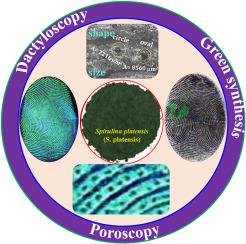用于增强潜指纹显影和孔镜的掺杂 Ho³⁺ BaGd₂ZnO₅ 纳米磷的合成与应用
IF 4.3
3区 材料科学
Q2 MATERIALS SCIENCE, MULTIDISCIPLINARY
引用次数: 0
摘要
本研究利用螺旋藻叶提取物作为天然绿色燃料,通过燃烧合成法合成了掺杂Ho³⁺的BaGd₂ZnO₅(1-11 mol%)纳米荧光粉(BGZO:Ho3+ NPs)。发光研究表明,BGZO:Ho³⁺荧光粉表现出强烈的绿色发射,这主要源于 Ho³⁺ 离子的 5S2→5I8 转变。最佳掺杂浓度为 7 mol % Ho³⁺,发光效率最高。此外,BGZO:7Ho³⁺ 的 CIE 色度坐标被精确测定为 (0.2595, 0.7290),色纯度 (CP) 为 99.98%。这些结果表明,这种材料具有生产适用于固态照明和显示应用的高质量绿色光源的潜力。优化后的 BGZO:Ho3+ NPs 通过粉末撒粉法用于潜伏指纹(LFP)的显影。在 365 nm 紫外光下,该 NPs 能在玻璃、塑料和金属等不同基底上有效显示 I-III 级指纹(FPs)的细节,包括脊纹、细微特征和汗孔特征。在紫外光照射下,BGZO:Ho3+ NPs 发出高亮度的荧光,提供了一种灵敏且非破坏性的方法来提高指纹的可见度,使其成为一种很有前途的法医应用工具。此外,本研究还关注 FPs 的孔镜技术,研究 LFPs 的详细孔隙结构,用于法医鉴定。利用先进的成像技术,我们分析了不同基质和条件下的汗孔分布、大小和形状。对 LFP 进行了详细的孔镜分析,重点关注孔隙间距(165-332 μm)、孔隙大小(4140-9956 μm2)、形状(椭圆形、斜方形、三角形、正方形和长方形)和孔隙角度(167°-179°)等关键参数。此外,还使用基于 Python- 的软件开发了一个数学模型,以便对 FPs 进行精确和准确的分析,提高清晰度和识别准确性,支持脊状图案以外的 FPs 的独特性。研究结果表明,通过提供额外的精确生物识别数据,孔镜具有增强 FP 分析的潜力。本文章由计算机程序翻译,如有差异,请以英文原文为准。

Synthesis and application of Ho³⁺ doped BaGd₂ZnO₅ nanophosphors for enhanced latent fingerprint development and poroscopy
In this study, Ho³⁺-doped BaGd₂ZnO₅ (1–11 mol%) nanophosphors (BGZO:Ho3+ NPs) were synthesized through combustion synthesis, utilizing Spirulina leaf extract as a natural green fuel. Luminescence studies revealed that the BGZO:Ho³⁺ phosphors exhibit a strong green emission primarily resulting from the 5S2→5I8 transition of Ho³⁺ ions. The optimal doping concentration was found to be 7 mol % Ho³⁺, which yielded the highest luminescence efficiency. Furthermore, the CIE chromaticity coordinates for BGZO:7Ho³⁺ were accurately determined to be (0.2595, 0.7290), with a color purity (CP) of 99.98 %. These results indicate the potential of this material for producing high-quality green emissions suitable for solid-state lighting and display applications. Optimized BGZO:Ho3+ NPs were utilized for latent fingerprints (LFPs) development via the powder dusting method. Under 365 nm UV light, the NPs effectively revealed Level I-III fingerprints (FPs) details, including ridge patterns, minutiae, and sweat pore features, on various substrates such as glass, plastic, and metal. The high luminescence of BGZO:Ho3+ NPs under UV illumination offers a sensitive and non-destructive method for enhancing FPs visibility, making it a promising tool for forensic applications. In addition, this study focuses on FPs poroscopy, examining the detailed pore structure of LFPs for forensic identification. Using advanced imaging techniques, we analyzed sweat pore distribution, size, and shape across various substrates and conditions. A detailed poroscopic analysis of LFPs, focusing on key parameters such as pore interspacing (165–332 μm), pore size (4140–9956 μm2), shapes (elliptical, rhomboid, triangular, square and rectangular) and pore angle (167°–179°). Further, a mathematical model was developed using Python-based software to enable precise and accurate analysis of FPs, enhancing clarity and identification accuracy, supporting the uniqueness of FPs beyond ridge patterns. The results demonstrate the potential of poroscopy for enhancing FPs analysis by offering an additional layer of precise biometric data.
求助全文
通过发布文献求助,成功后即可免费获取论文全文。
去求助
来源期刊

Materials Chemistry and Physics
工程技术-材料科学:综合
CiteScore
8.70
自引率
4.30%
发文量
1515
审稿时长
69 days
期刊介绍:
Materials Chemistry and Physics is devoted to short communications, full-length research papers and feature articles on interrelationships among structure, properties, processing and performance of materials. The Editors welcome manuscripts on thin films, surface and interface science, materials degradation and reliability, metallurgy, semiconductors and optoelectronic materials, fine ceramics, magnetics, superconductors, specialty polymers, nano-materials and composite materials.
 求助内容:
求助内容: 应助结果提醒方式:
应助结果提醒方式:


